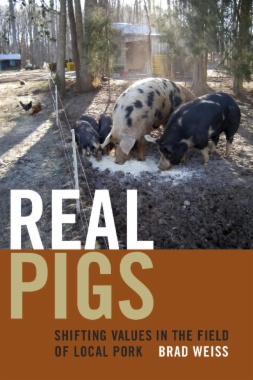In addition to being one of the United States' largest pork producers, North Carolina is home to a developing niche market of pasture-raised pork. In Real Pigs Brad Weiss traces the desire for "authentic" local foods in the Piedmont region of central North Carolina as he follows farmers, butchers, and chefs through the process of breeding, raising, butchering, selling, and preparing pigs raised on pasture for consumption. Drawing on his experience working on Piedmont pig farms and at farmers’ markets, Weiss explores the history, values, social relations, and practices that drive the pasture-raised pork market. He shows how pigs in the Piedmont become imbued with notions of authenticity, illuminating the ways the region's residents understand local notions of place and culture. Full of anecdotes and interviews with the market's primary figures, Real Pigs reminds us that what we eat and why have implications that resonate throughout the wider social, cultural, and historical world.
- Cover
- Contents
- Preface
- Acknowledgments
- Introduction
- Chapter 1: Pigs on the Ground
- Chapter 2: Pigs in a Local Place
- Chapter 3: Heritage, Hybrids, Breeds, and Brands
- Chapter 4: Pigs in Parts
- Chapter 5: A Taste for Fat
- Chapter 6: Farm to Fork, Snout to Tail
- Conclusion
- Notes
- References
- Index
- A
- B
- C
- D
- E
- F
- G
- H
- I
- J
- K
- L
- M
- N
- O
- P
- Q
- R
- S
- T
- U
- V
- W

